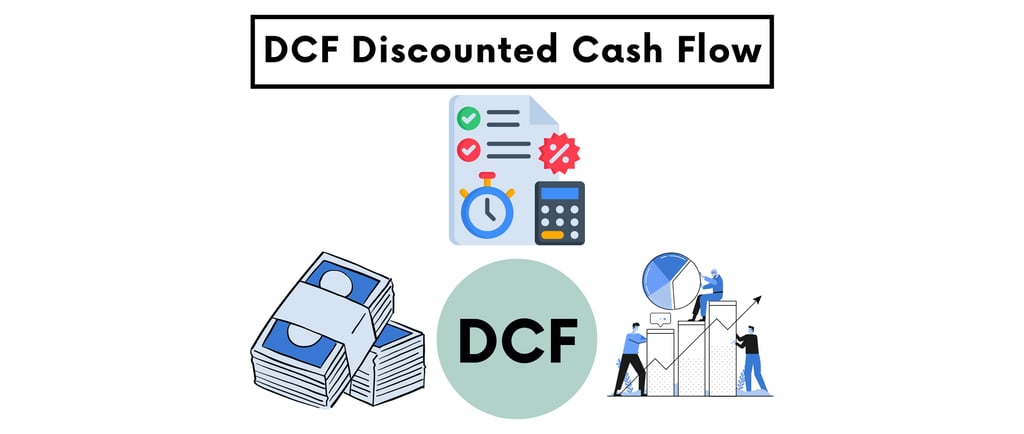Understanding Discounted Cash Flow (DCF) for Stock Valuation


INTRODUCTION
When it comes to investing in stocks, knowing whether a company is fairly valued, overvalued, or undervalued can make a huge difference in long-term returns. One of the most respected methods used by investors, analysts, and financial professionals is the Discounted Cash Flow (DCF) model.
DCF may sound technical at first, but once you understand the core logic, it becomes a powerful tool that helps investors evaluate the true worth of a business. In this blog, we will break down what DCF is, how it works, and why it matters in stock valuation. By the end, you’ll have a solid understanding of how companies are valued based on the cash they generate.
What Is Discounted Cash Flow (DCF)?
Discounted Cash Flow is a valuation method used to estimate the intrinsic value of an investment based on its expected future cash flows. The main idea behind DCF is simple: the value of a business is equal to the cash it is expected to generate in the future — but adjusted to reflect the time value of money. The time value of money means that a rupee today is worth more than a rupee in the future. So when valuing future cash flows, we apply a discount rate to bring them back to their present value. This process is what we call “discounting.”If the current price of the stock is lower than the DCF valuation, it may be considered undervalued and attractive for investment. If it is higher, the stock may be overvalued.
Why Use DCF for Stock Valuation?
DCF is popular because it focuses on fundamentals — it values a company based on how much money it will generate for its owners, rather than market hype, news headlines, or short-term speculation. Unlike price multiples such as P/E or P/B ratios, which compare a company to others, DCF is an absolute valuation method. It tells you what a company is worth on its terms. That makes it especially useful for long-term investors who want to invest based on business quality and earnings potential, not just short-term price action.
Key Components of a DCF Model
To perform a DCF valuation, you need a few key inputs:
First, estimate the company’s free cash flows over the next few years. Free cash flow is the cash a company generates after accounting for capital expenditures. It is a good measure of the money available to shareholders.
Then, estimate the terminal value, which is the value of the company beyond the forecast period. This is important because businesses do not stop operating after five or ten years.
Next, choose a discount rate. This is often based on the company’s weighted average cost of capital, or WACC. The discount rate reflects the risk of the investment — higher risk means higher discount rates, which lower the present value. Finally, discount all future cash flows back to the present using the chosen rate. The sum of these present values is the company’s intrinsic value. If this intrinsic value is more than the current market price, the stock could be a good buy.
A Simple DCF Example
Imagine a company is expected to generate 100 crore in free cash flow next year, and that amount is expected to grow at a steady rate for the next five years. We then estimate the company’s value beyond year five, add it all together, and discount the total cash flows using a rate of 10 percent. Let’s say the final DCF value comes out to be 1,200 crore. If the company’s current market capitalization is 950 crore, then the stock may be undervalued by the market, making it potentially attractive for investors. Of course, these numbers are based on assumptions. The better your assumptions, the more accurate your valuation.
The Role of Assumptions in DCF
One of the most important things to remember about DCF is that it depends heavily on assumptions. Your estimate of future cash flows, growth rates, terminal value, and discount rate will all impact the final result. Small changes in these inputs can lead to big changes in valuation. That’s why DCF is not an exact science. It’s a framework for thinking about value. The goal is not to predict the future perfectly, but to get close enough to make better-informed decisions. Experienced investors often run multiple DCF scenarios — optimistic, base case, and pessimistic — to see a range of potential outcomes and risks.
Advantages of DCF
DCF is based on long-term fundamentals, not market speculation. It gives investors a clear sense of what a business is worth over time. It is also flexible and can be adapted to many types of businesses. DCF helps you avoid overpaying for stocks based on hype, and encourages rational, disciplined investing.
Limitations of DCF
Despite its strengths, DCF has limitations. It is only as accurate as the inputs you use. Forecasting cash flows five or ten years into the future is difficult, especially for businesses in fast-changing industries. DCF also may not work well for companies with inconsistent cash flows or businesses that are not yet profitable, such as startups or early-stage tech firms. That’s why DCF is often best used for established, cash-generating companies with a stable growth outlook.
When to Use DCF
DCF is most useful when analyzing mature companies with predictable earnings. It is especially valuable for investors who prefer fundamental analysis and want to determine whether a stock is truly undervalued. Value investors like Warren Buffett have often emphasized the importance of intrinsic value and future cash flows. While Buffett rarely shares his DCF spreadsheets, the principles behind his investment decisions align closely with the logic of DCF.
Final Thoughts
Discounted Cash Flow is one of the most important concepts in stock valuation. It allows investors to look beyond the market price and ask a deeper question: What is this business actually worth? By focusing on future cash flows and applying the time value of money, DCF gives a rational and structured way to estimate value. Like any tool, it requires thoughtful use, careful assumptions, and regular updates. If you’re serious about long-term investing, learning to use DCF — even in its simplest form — can give you an edge. It helps you tune out the noise, focus on fundamentals, and make decisions based on value, not just price. As with all investing methods, it’s not about perfection — it’s about discipline and clarity. And DCF is one of the best tools to help you achieve that.


